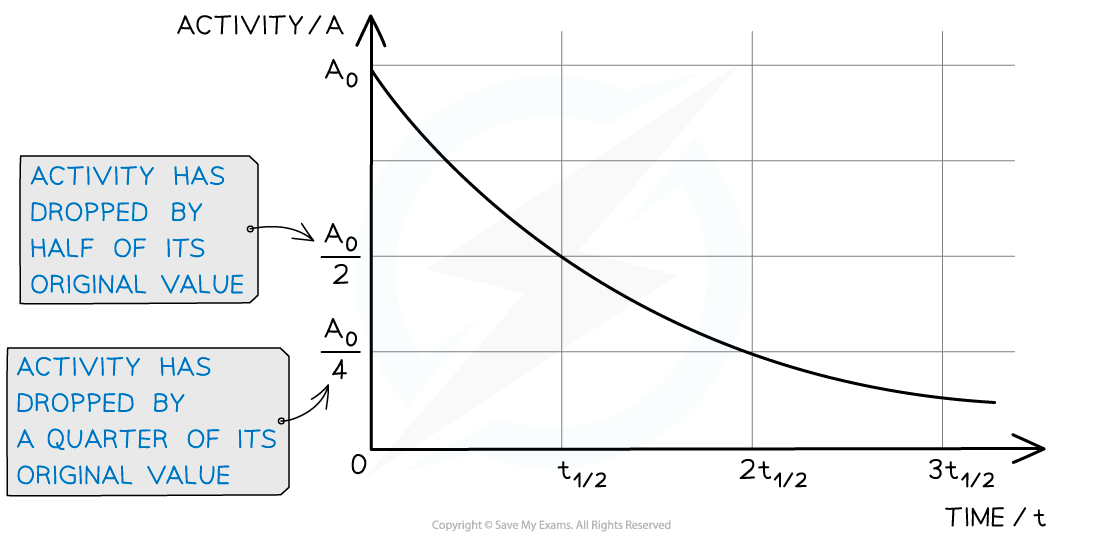Half-Life (OCR A Level Physics): Revision Note
Exam code: H556
Half-Life
Half life is defined as:
The time taken for the initial number of nuclei to reduce by half
This means that when a time equal to the half-life has passed, the activity of the sample will be half of its original value
This is because activity is proportional to the number of undecayed nuclei,

When a time equal to the half-life passes, the activity falls by half, when two half-lives pass, the activity falls by another half (which is a quarter of the initial value)
To find an expression for half-life, start with the equation for exponential decay:
Where:
N = number of nuclei remaining in a sample
N0 = the initial number of undecayed nuclei (when t = 0)
λ = decay constant (s-1)
t = time interval (s)
When time
is equal to the half-life
, the activity
of the sample will be half of its original value, so
The formula can then be derived by first dividing both sides by
:
Then, taking the natural log of both sides:
Finally, applying properties of logarithms:
Therefore, half-life
can be calculated using the equation:
This equation shows that half-life
and the radioactive decay rate constant λ are inversely proportional
Therefore, the shorter the half-life, the larger the decay constant and the faster the decay
Worked Example
Strontium-90 is a radioactive isotope with a half-life of 28.0 years. A sample of strontium-90 has an activity of 6.4 × 109 Bq.
Calculate the decay constant , in s–1, of strontium-90.
Answer:
Step 1: Convert the half-life into seconds
= 28 years = 28 × (365 × 24 × 60 × 60) = 8.83 × 108 s
Step 2: Write the equation for half-life
Step 3: Rearrange for λ and calculate
Examiner Tips and Tricks
Make sure you are confident with the meanings of all the definitions and symbols in this unit. It is easy to get confused when completing an examination question.
Determining the Half-Life of an Isotope
Aim of the experiment
The aim of this experiment is to determine the half-life of an isotope such as protactinium
Variables:
Independent variable = time,
(s)
Dependent variable = corrected count rate,
Control variables:
Radioactive source
Distance of GM tube to source
Location / background radiation
Equipment list
Equipment | Purpose |
|---|---|
sealed bottle containing uranium salt solution and protactinium-234 | to use as a source of radioactive emission |
Geiger-Muller tube and counter or datalogger | to measure the count rate of the radioactive source |
stopwatch | to measure the same time interval for each count rate reading |
tray lined with paper towel | to avoid contamination should the bottle leak |
Method
Apparatus for determining the half-life of protactinium-234

In the lower layer of the sealed bottle, uranium-238 decays to thorium-234 and then to protactinium-234. Shaking the bottle separates the isotopes as protactinium dissolves in the organic solvent, whereas thorium does not.
Connect the Geiger-Müller tube to the counter and, without any sources present, measure background radiation over a period of one minute
Repeat this three times, and take an average. Subtract this value from all subsequent readings.
Shake the bottle gently for 15 seconds to dissolve the protactinium in the organic layer, then wait for it to float to the top
This is done because the uranium salt in the aqueous layer decays to form protactinium, which is soluble in the organic solvent but insoluble in the aqueous layer
Align the GM tube with the organic layer and immediately start a stopwatch
Record the number of counts in 10 seconds, and repeat every 30 seconds
A suitable table of results might look like this:
Time, | Count rate | Corrected count rate, |
|---|---|---|
0 | ||
30 | ||
60 | ||
90 | ||
120 | ||
150 |
Analysis of results
The count rate of the source decreases exponentially according to
Taking the natural logs of both sides
Compared to the equation of a straight line
:
y-axis variable,
x-axis variable,
gradient =
y-intercept =
Subtract the background radiation from each count rate reading to give the corrected count rate
Plot a graph of
against time
Determine the half-life
from the gradient of the best-fit line
Log graph of corrected count rate against time

By plotting a log graph of ln C against time, the decay constant and half-life can be found directly from the gradient
Evaluating the experiment
Systematic Errors:
Position the GM tube close to the bottle, but make sure they don't touch
This ensures that only the beta particles from the protactinium are detected, and not the alpha particles from the uranium sample (which are absorbed by the bottle)
Random Errors:
Radioactive decay is random, so repeat readings are vital in this experiment
The half-life of protactinium is short, so more frequent readings of count rate may be necessary
Safety considerations
Protactinium-234 is safe to use due to its short half-life
Ensure the bottle remains sealed at all times to prevent leakage
Handle the bottle with long tongs
Safety clothing such as a lab coat, gloves and goggles must be worn

You've read 0 of your 5 free revision notes this week
Unlock more, it's free!
Did this page help you?